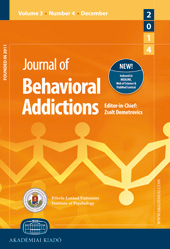Gamblers seeking treatment: Who does and who doesn’t?
Gamblers seeking treatment: Who does and who doesn’t?
Author(s): Barbara Braun, Monika Ludwig, Pawel Sleczka, Gerhard Bühringer, Ludwig KrausSubject(s): Psychology, Behaviorism, Substance abuse and addiction, Health and medicine and law, Socio-Economic Research
Published by: Akadémiai Kiadó
Keywords: treatment-seeking; predictors; pathological gamblers; subclinical pathological gamblers; addiction care;
Summary/Abstract: As only a minority of pathological gamblers (PGr) presents for treatment, further knowledge about help-seeking behavior is required in order to enhance treatment utilization. The present study investigated factors associated with treatment participation in gamblers in Germany. As subclinical pathological gamblers (SPGr, fulfilling one to four DSM-IV-criteria) are target of early intervention due to high risk of transition to pathological gambling, they were subject of special interest. Methods: The study analyzed data from a general population survey (n = 234, SPGr: n = 198, PGr: n = 36) and a treatment study (n = 329, SPGr: n = 22, PGr: n = 307). A two-step weighting procedure was applied to ensure comparability of samples. Investigated factors included socio-demographic variables, gambling behavior, symptoms of pathological gambling and substance use. Results: In PGr, regular employment and non-German nationality were positively associated with being in treatment while gambling on the Internet and gaming machines and fulfilling more DSM-IV-criteria lowered the odds. In SPGr, treatment attendance was negatively associated with married status and alcohol consumption and positively associated with older age, higher stakes, more fulfilled DSM-IV criteria and regular smoking. Conclusions: In accordance to expectations more severe gambling problems and higher problem awareness and/or external pressure might facilitate treatment entry. There are groups with lower chances of being in treatment: women, ethnic minorities, and SPGr. We propose target group specific offers, use of Internet-based methods as possible adaptions and/or extensions of treatment offers that could enhance treatment attendance.
Journal: Journal of Behavioral Addictions
- Issue Year: 3/2014
- Issue No: 3
- Page Range: 189-198
- Page Count: 10
- Language: English

